HRM Report: Functions, Practices, and Legislation at HSBC Bank
VerifiedAdded on 2020/06/04
|19
|5966
|84
Report
AI Summary
This report provides a comprehensive analysis of Human Resource Management (HRM) practices within HSBC Bank. It begins with an introduction to HRM, its core functions, and the role of HR directors. The report then delves into the strengths and weaknesses of various recruitment and selection approaches, comparing internal and external sources. The study further explores the benefits of different HRM practices for both employees and employers, including employee development, performance management, and fostering positive employee relations. The report also examines the effectiveness of these practices in terms of productivity and profit. It emphasizes the importance of employee relations in HRM decision-making and discusses the impact of employment legislation on personnel decisions. Finally, the report concludes with an overview of the application of human resource practices within the organization, referencing specific examples from HSBC. The report covers topics such as workforce planning, hard and soft approaches, managerial functions, and selection processes, offering a detailed insight into HRM strategies at HSBC.
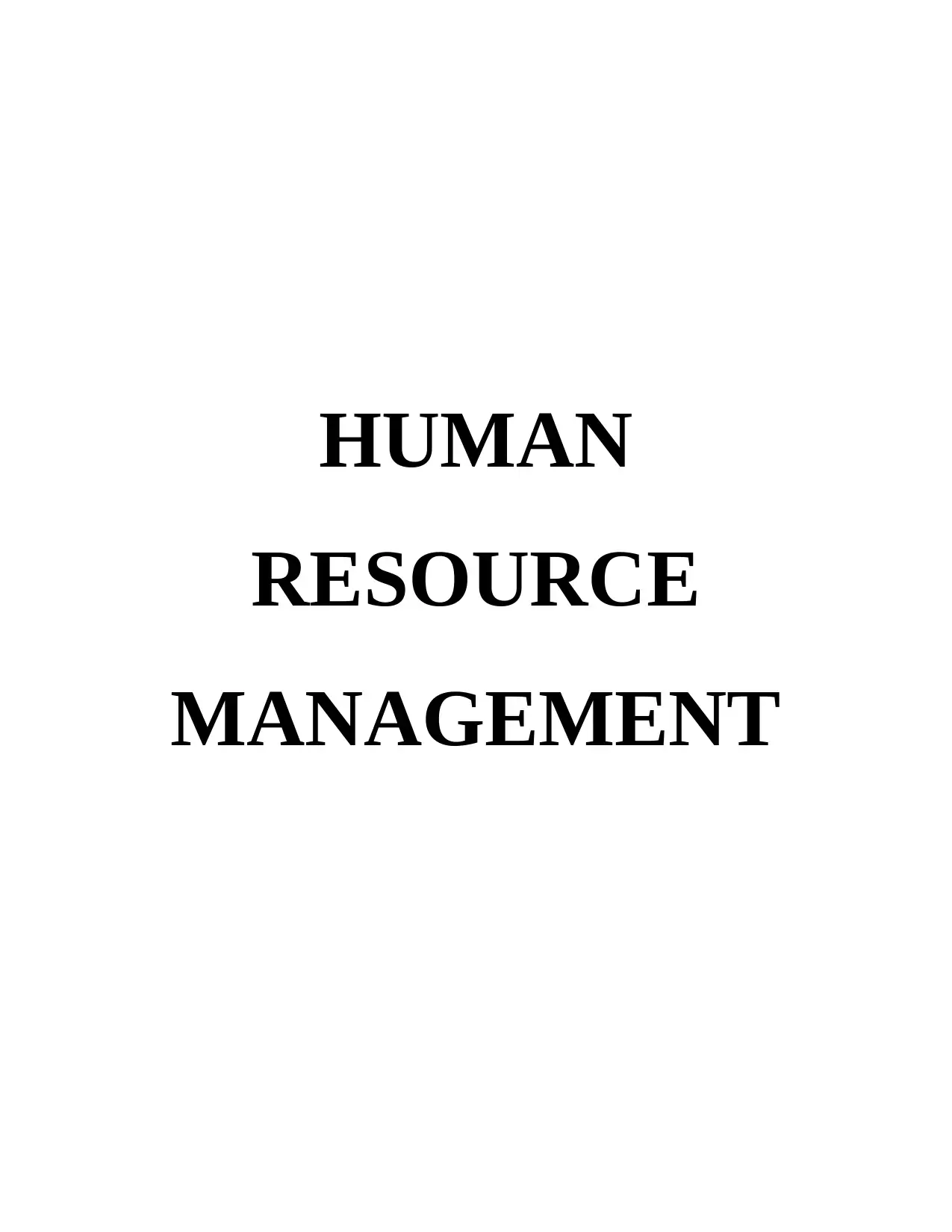
HUMAN
RESOURCE
MANAGEMENT
RESOURCE
MANAGEMENT
Paraphrase This Document
Need a fresh take? Get an instant paraphrase of this document with our AI Paraphraser
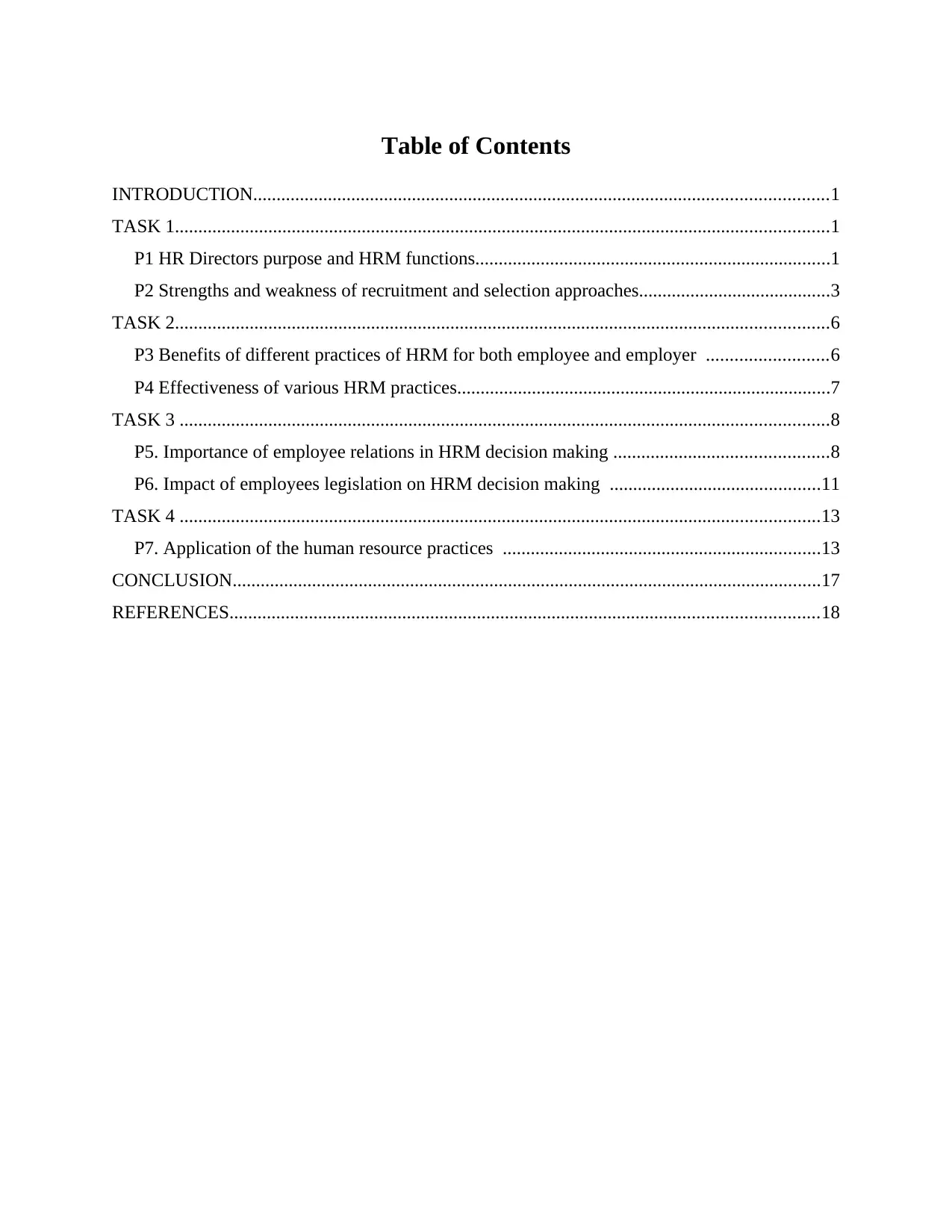
Table of Contents
INTRODUCTION...........................................................................................................................1
TASK 1............................................................................................................................................1
P1 HR Directors purpose and HRM functions............................................................................1
P2 Strengths and weakness of recruitment and selection approaches.........................................3
TASK 2............................................................................................................................................6
P3 Benefits of different practices of HRM for both employee and employer ..........................6
P4 Effectiveness of various HRM practices................................................................................7
TASK 3 ...........................................................................................................................................8
P5. Importance of employee relations in HRM decision making ..............................................8
P6. Impact of employees legislation on HRM decision making .............................................11
TASK 4 .........................................................................................................................................13
P7. Application of the human resource practices ....................................................................13
CONCLUSION..............................................................................................................................17
REFERENCES..............................................................................................................................18
INTRODUCTION...........................................................................................................................1
TASK 1............................................................................................................................................1
P1 HR Directors purpose and HRM functions............................................................................1
P2 Strengths and weakness of recruitment and selection approaches.........................................3
TASK 2............................................................................................................................................6
P3 Benefits of different practices of HRM for both employee and employer ..........................6
P4 Effectiveness of various HRM practices................................................................................7
TASK 3 ...........................................................................................................................................8
P5. Importance of employee relations in HRM decision making ..............................................8
P6. Impact of employees legislation on HRM decision making .............................................11
TASK 4 .........................................................................................................................................13
P7. Application of the human resource practices ....................................................................13
CONCLUSION..............................................................................................................................17
REFERENCES..............................................................................................................................18
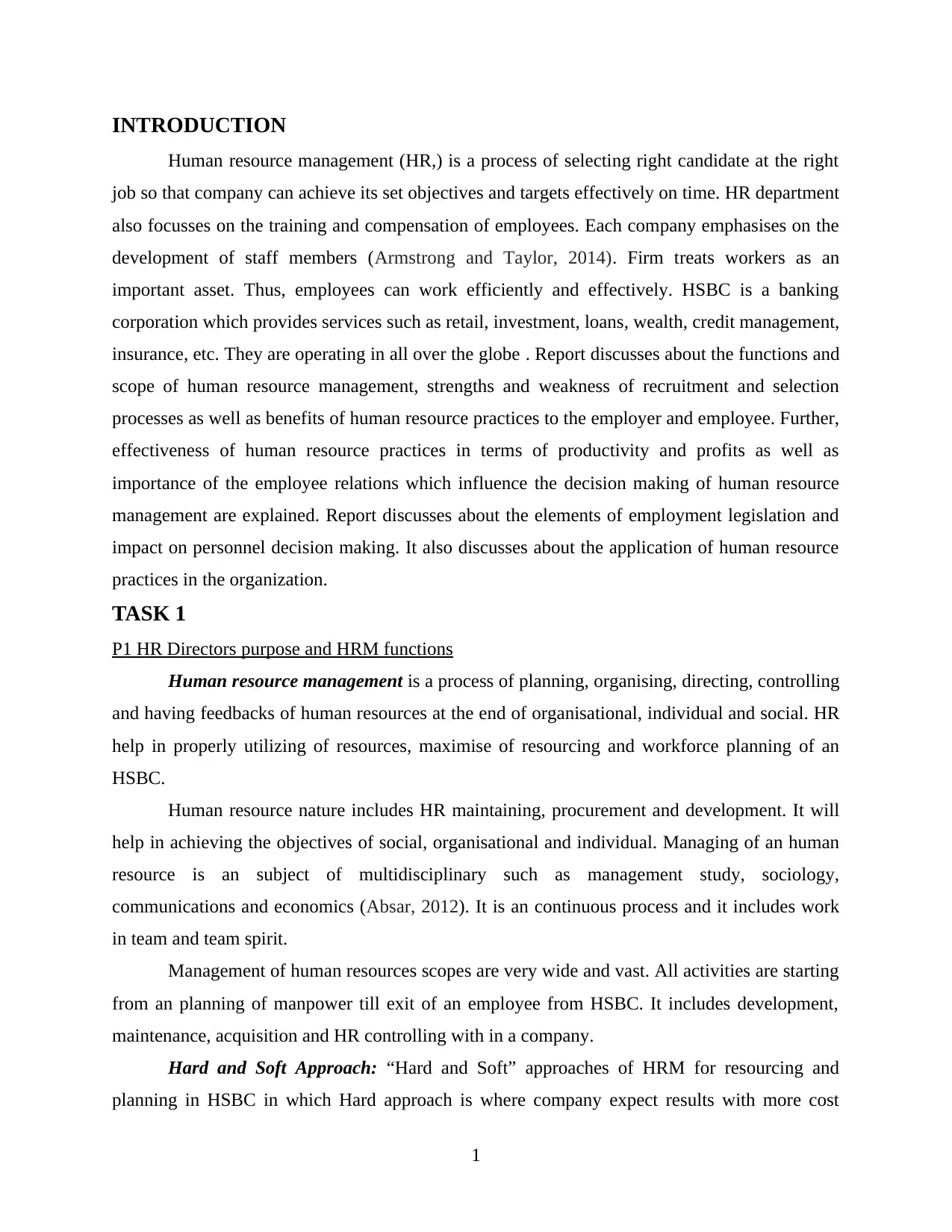
INTRODUCTION
Human resource management (HR,) is a process of selecting right candidate at the right
job so that company can achieve its set objectives and targets effectively on time. HR department
also focusses on the training and compensation of employees. Each company emphasises on the
development of staff members (Armstrong and Taylor, 2014). Firm treats workers as an
important asset. Thus, employees can work efficiently and effectively. HSBC is a banking
corporation which provides services such as retail, investment, loans, wealth, credit management,
insurance, etc. They are operating in all over the globe . Report discusses about the functions and
scope of human resource management, strengths and weakness of recruitment and selection
processes as well as benefits of human resource practices to the employer and employee. Further,
effectiveness of human resource practices in terms of productivity and profits as well as
importance of the employee relations which influence the decision making of human resource
management are explained. Report discusses about the elements of employment legislation and
impact on personnel decision making. It also discusses about the application of human resource
practices in the organization.
TASK 1
P1 HR Directors purpose and HRM functions
Human resource management is a process of planning, organising, directing, controlling
and having feedbacks of human resources at the end of organisational, individual and social. HR
help in properly utilizing of resources, maximise of resourcing and workforce planning of an
HSBC.
Human resource nature includes HR maintaining, procurement and development. It will
help in achieving the objectives of social, organisational and individual. Managing of an human
resource is an subject of multidisciplinary such as management study, sociology,
communications and economics (Absar, 2012). It is an continuous process and it includes work
in team and team spirit.
Management of human resources scopes are very wide and vast. All activities are starting
from an planning of manpower till exit of an employee from HSBC. It includes development,
maintenance, acquisition and HR controlling with in a company.
Hard and Soft Approach: “Hard and Soft” approaches of HRM for resourcing and
planning in HSBC in which Hard approach is where company expect results with more cost
1
Human resource management (HR,) is a process of selecting right candidate at the right
job so that company can achieve its set objectives and targets effectively on time. HR department
also focusses on the training and compensation of employees. Each company emphasises on the
development of staff members (Armstrong and Taylor, 2014). Firm treats workers as an
important asset. Thus, employees can work efficiently and effectively. HSBC is a banking
corporation which provides services such as retail, investment, loans, wealth, credit management,
insurance, etc. They are operating in all over the globe . Report discusses about the functions and
scope of human resource management, strengths and weakness of recruitment and selection
processes as well as benefits of human resource practices to the employer and employee. Further,
effectiveness of human resource practices in terms of productivity and profits as well as
importance of the employee relations which influence the decision making of human resource
management are explained. Report discusses about the elements of employment legislation and
impact on personnel decision making. It also discusses about the application of human resource
practices in the organization.
TASK 1
P1 HR Directors purpose and HRM functions
Human resource management is a process of planning, organising, directing, controlling
and having feedbacks of human resources at the end of organisational, individual and social. HR
help in properly utilizing of resources, maximise of resourcing and workforce planning of an
HSBC.
Human resource nature includes HR maintaining, procurement and development. It will
help in achieving the objectives of social, organisational and individual. Managing of an human
resource is an subject of multidisciplinary such as management study, sociology,
communications and economics (Absar, 2012). It is an continuous process and it includes work
in team and team spirit.
Management of human resources scopes are very wide and vast. All activities are starting
from an planning of manpower till exit of an employee from HSBC. It includes development,
maintenance, acquisition and HR controlling with in a company.
Hard and Soft Approach: “Hard and Soft” approaches of HRM for resourcing and
planning in HSBC in which Hard approach is where company expect results with more cost
1
⊘ This is a preview!⊘
Do you want full access?
Subscribe today to unlock all pages.

Trusted by 1+ million students worldwide
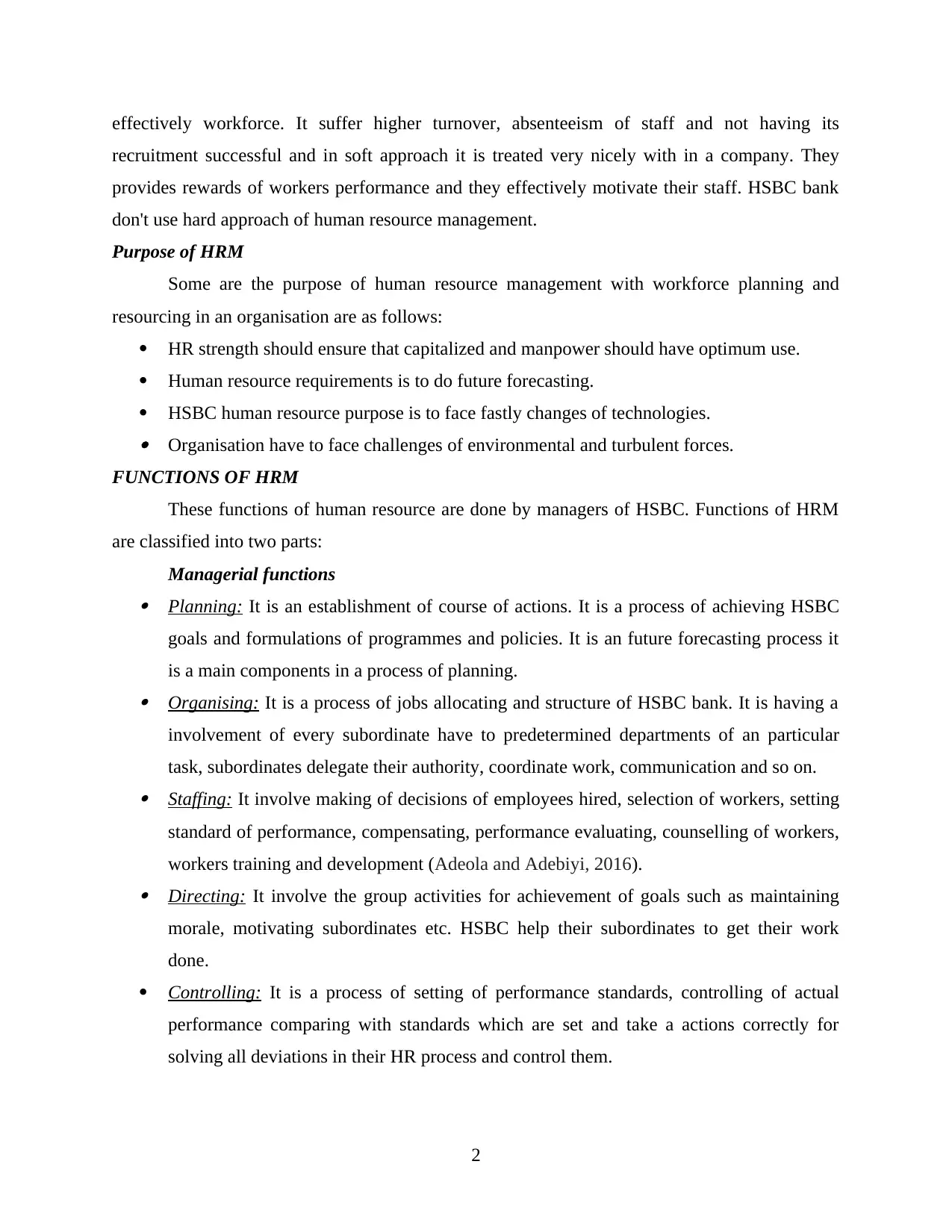
effectively workforce. It suffer higher turnover, absenteeism of staff and not having its
recruitment successful and in soft approach it is treated very nicely with in a company. They
provides rewards of workers performance and they effectively motivate their staff. HSBC bank
don't use hard approach of human resource management.
Purpose of HRM
Some are the purpose of human resource management with workforce planning and
resourcing in an organisation are as follows:
HR strength should ensure that capitalized and manpower should have optimum use.
Human resource requirements is to do future forecasting.
HSBC human resource purpose is to face fastly changes of technologies. Organisation have to face challenges of environmental and turbulent forces.
FUNCTIONS OF HRM
These functions of human resource are done by managers of HSBC. Functions of HRM
are classified into two parts:
Managerial functions Planning: It is an establishment of course of actions. It is a process of achieving HSBC
goals and formulations of programmes and policies. It is an future forecasting process it
is a main components in a process of planning. Organising: It is a process of jobs allocating and structure of HSBC bank. It is having a
involvement of every subordinate have to predetermined departments of an particular
task, subordinates delegate their authority, coordinate work, communication and so on. Staffing: It involve making of decisions of employees hired, selection of workers, setting
standard of performance, compensating, performance evaluating, counselling of workers,
workers training and development (Adeola and Adebiyi, 2016). Directing: It involve the group activities for achievement of goals such as maintaining
morale, motivating subordinates etc. HSBC help their subordinates to get their work
done.
Controlling: It is a process of setting of performance standards, controlling of actual
performance comparing with standards which are set and take a actions correctly for
solving all deviations in their HR process and control them.
2
recruitment successful and in soft approach it is treated very nicely with in a company. They
provides rewards of workers performance and they effectively motivate their staff. HSBC bank
don't use hard approach of human resource management.
Purpose of HRM
Some are the purpose of human resource management with workforce planning and
resourcing in an organisation are as follows:
HR strength should ensure that capitalized and manpower should have optimum use.
Human resource requirements is to do future forecasting.
HSBC human resource purpose is to face fastly changes of technologies. Organisation have to face challenges of environmental and turbulent forces.
FUNCTIONS OF HRM
These functions of human resource are done by managers of HSBC. Functions of HRM
are classified into two parts:
Managerial functions Planning: It is an establishment of course of actions. It is a process of achieving HSBC
goals and formulations of programmes and policies. It is an future forecasting process it
is a main components in a process of planning. Organising: It is a process of jobs allocating and structure of HSBC bank. It is having a
involvement of every subordinate have to predetermined departments of an particular
task, subordinates delegate their authority, coordinate work, communication and so on. Staffing: It involve making of decisions of employees hired, selection of workers, setting
standard of performance, compensating, performance evaluating, counselling of workers,
workers training and development (Adeola and Adebiyi, 2016). Directing: It involve the group activities for achievement of goals such as maintaining
morale, motivating subordinates etc. HSBC help their subordinates to get their work
done.
Controlling: It is a process of setting of performance standards, controlling of actual
performance comparing with standards which are set and take a actions correctly for
solving all deviations in their HR process and control them.
2
Paraphrase This Document
Need a fresh take? Get an instant paraphrase of this document with our AI Paraphraser
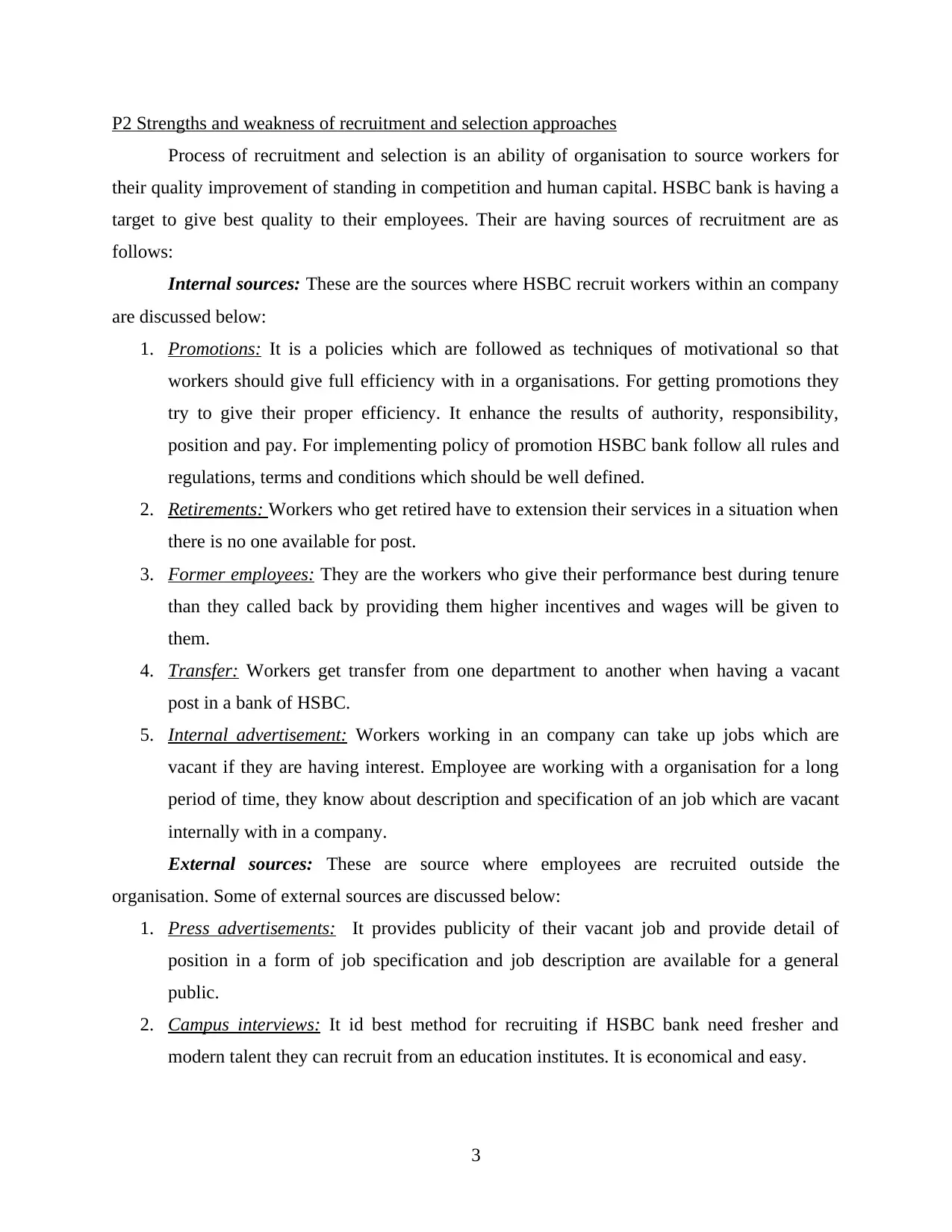
P2 Strengths and weakness of recruitment and selection approaches
Process of recruitment and selection is an ability of organisation to source workers for
their quality improvement of standing in competition and human capital. HSBC bank is having a
target to give best quality to their employees. Their are having sources of recruitment are as
follows:
Internal sources: These are the sources where HSBC recruit workers within an company
are discussed below:
1. Promotions: It is a policies which are followed as techniques of motivational so that
workers should give full efficiency with in a organisations. For getting promotions they
try to give their proper efficiency. It enhance the results of authority, responsibility,
position and pay. For implementing policy of promotion HSBC bank follow all rules and
regulations, terms and conditions which should be well defined.
2. Retirements: Workers who get retired have to extension their services in a situation when
there is no one available for post.
3. Former employees: They are the workers who give their performance best during tenure
than they called back by providing them higher incentives and wages will be given to
them.
4. Transfer: Workers get transfer from one department to another when having a vacant
post in a bank of HSBC.
5. Internal advertisement: Workers working in an company can take up jobs which are
vacant if they are having interest. Employee are working with a organisation for a long
period of time, they know about description and specification of an job which are vacant
internally with in a company.
External sources: These are source where employees are recruited outside the
organisation. Some of external sources are discussed below:
1. Press advertisements: It provides publicity of their vacant job and provide detail of
position in a form of job specification and job description are available for a general
public.
2. Campus interviews: It id best method for recruiting if HSBC bank need fresher and
modern talent they can recruit from an education institutes. It is economical and easy.
3
Process of recruitment and selection is an ability of organisation to source workers for
their quality improvement of standing in competition and human capital. HSBC bank is having a
target to give best quality to their employees. Their are having sources of recruitment are as
follows:
Internal sources: These are the sources where HSBC recruit workers within an company
are discussed below:
1. Promotions: It is a policies which are followed as techniques of motivational so that
workers should give full efficiency with in a organisations. For getting promotions they
try to give their proper efficiency. It enhance the results of authority, responsibility,
position and pay. For implementing policy of promotion HSBC bank follow all rules and
regulations, terms and conditions which should be well defined.
2. Retirements: Workers who get retired have to extension their services in a situation when
there is no one available for post.
3. Former employees: They are the workers who give their performance best during tenure
than they called back by providing them higher incentives and wages will be given to
them.
4. Transfer: Workers get transfer from one department to another when having a vacant
post in a bank of HSBC.
5. Internal advertisement: Workers working in an company can take up jobs which are
vacant if they are having interest. Employee are working with a organisation for a long
period of time, they know about description and specification of an job which are vacant
internally with in a company.
External sources: These are source where employees are recruited outside the
organisation. Some of external sources are discussed below:
1. Press advertisements: It provides publicity of their vacant job and provide detail of
position in a form of job specification and job description are available for a general
public.
2. Campus interviews: It id best method for recruiting if HSBC bank need fresher and
modern talent they can recruit from an education institutes. It is economical and easy.
3
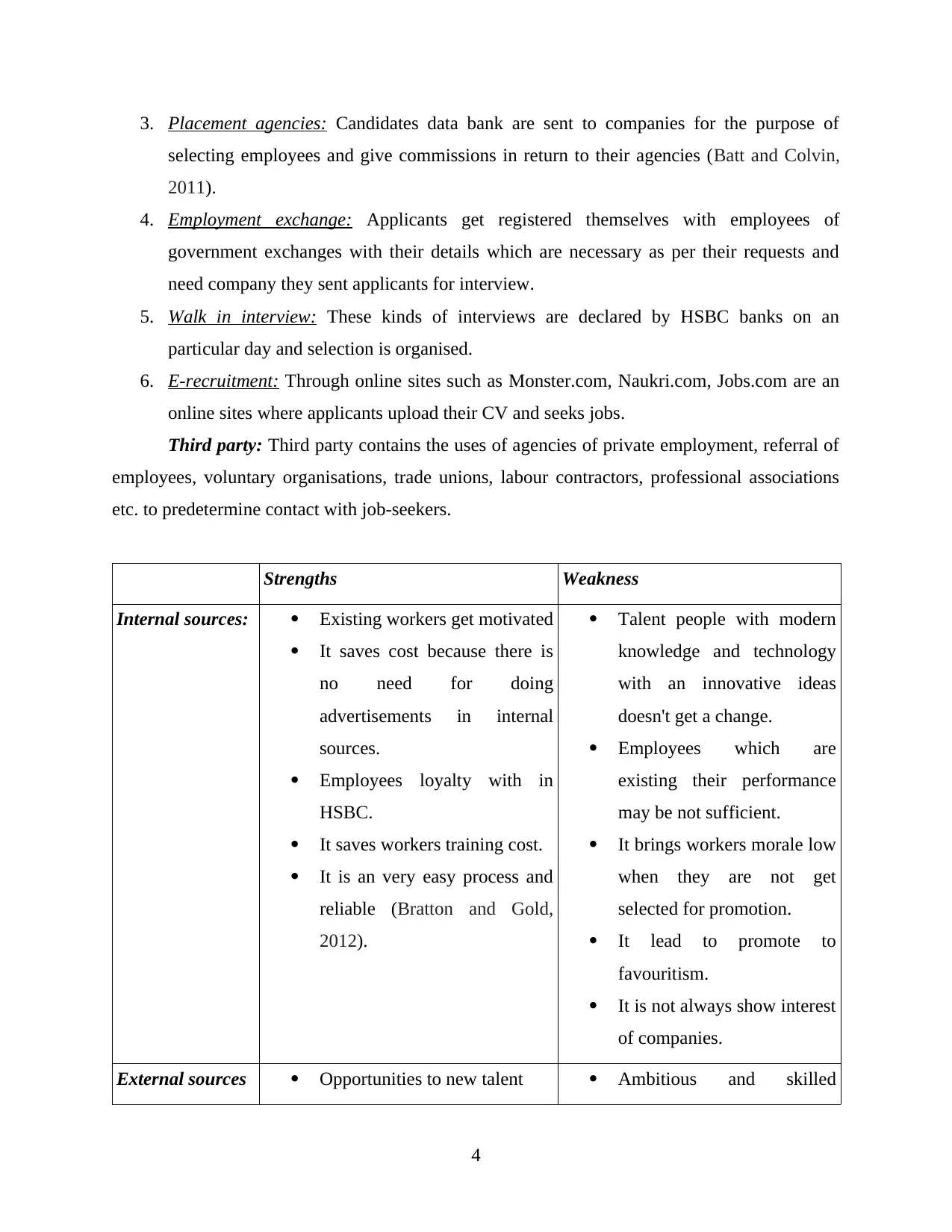
3. Placement agencies: Candidates data bank are sent to companies for the purpose of
selecting employees and give commissions in return to their agencies (Batt and Colvin,
2011).
4. Employment exchange: Applicants get registered themselves with employees of
government exchanges with their details which are necessary as per their requests and
need company they sent applicants for interview.
5. Walk in interview: These kinds of interviews are declared by HSBC banks on an
particular day and selection is organised.
6. E-recruitment: Through online sites such as Monster.com, Naukri.com, Jobs.com are an
online sites where applicants upload their CV and seeks jobs.
Third party: Third party contains the uses of agencies of private employment, referral of
employees, voluntary organisations, trade unions, labour contractors, professional associations
etc. to predetermine contact with job-seekers.
Strengths Weakness
Internal sources: Existing workers get motivated
It saves cost because there is
no need for doing
advertisements in internal
sources.
Employees loyalty with in
HSBC.
It saves workers training cost.
It is an very easy process and
reliable (Bratton and Gold,
2012).
Talent people with modern
knowledge and technology
with an innovative ideas
doesn't get a change.
Employees which are
existing their performance
may be not sufficient.
It brings workers morale low
when they are not get
selected for promotion.
It lead to promote to
favouritism.
It is not always show interest
of companies.
External sources Opportunities to new talent Ambitious and skilled
4
selecting employees and give commissions in return to their agencies (Batt and Colvin,
2011).
4. Employment exchange: Applicants get registered themselves with employees of
government exchanges with their details which are necessary as per their requests and
need company they sent applicants for interview.
5. Walk in interview: These kinds of interviews are declared by HSBC banks on an
particular day and selection is organised.
6. E-recruitment: Through online sites such as Monster.com, Naukri.com, Jobs.com are an
online sites where applicants upload their CV and seeks jobs.
Third party: Third party contains the uses of agencies of private employment, referral of
employees, voluntary organisations, trade unions, labour contractors, professional associations
etc. to predetermine contact with job-seekers.
Strengths Weakness
Internal sources: Existing workers get motivated
It saves cost because there is
no need for doing
advertisements in internal
sources.
Employees loyalty with in
HSBC.
It saves workers training cost.
It is an very easy process and
reliable (Bratton and Gold,
2012).
Talent people with modern
knowledge and technology
with an innovative ideas
doesn't get a change.
Employees which are
existing their performance
may be not sufficient.
It brings workers morale low
when they are not get
selected for promotion.
It lead to promote to
favouritism.
It is not always show interest
of companies.
External sources Opportunities to new talent Ambitious and skilled
4
⊘ This is a preview!⊘
Do you want full access?
Subscribe today to unlock all pages.

Trusted by 1+ million students worldwide
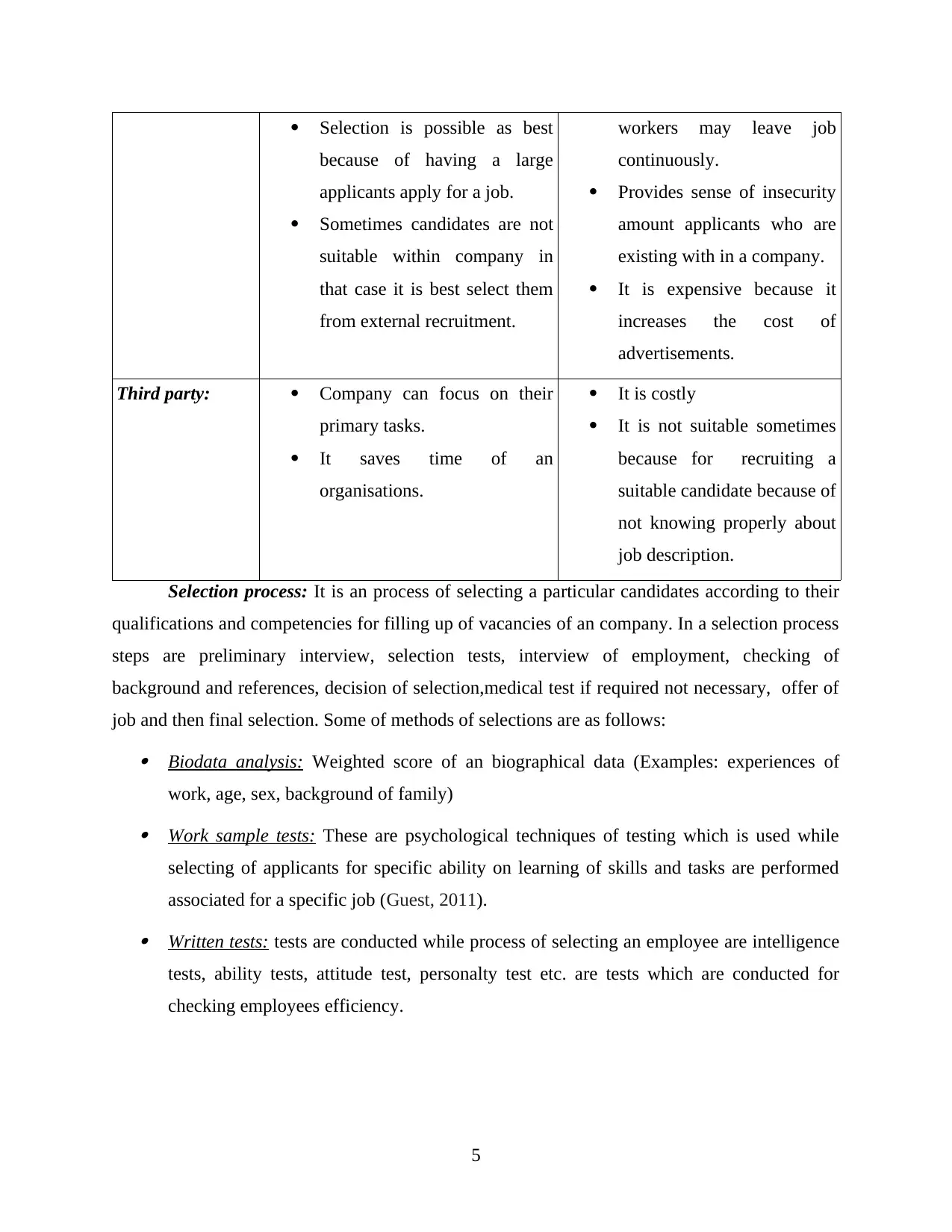
Selection is possible as best
because of having a large
applicants apply for a job.
Sometimes candidates are not
suitable within company in
that case it is best select them
from external recruitment.
workers may leave job
continuously.
Provides sense of insecurity
amount applicants who are
existing with in a company.
It is expensive because it
increases the cost of
advertisements.
Third party: Company can focus on their
primary tasks.
It saves time of an
organisations.
It is costly
It is not suitable sometimes
because for recruiting a
suitable candidate because of
not knowing properly about
job description.
Selection process: It is an process of selecting a particular candidates according to their
qualifications and competencies for filling up of vacancies of an company. In a selection process
steps are preliminary interview, selection tests, interview of employment, checking of
background and references, decision of selection,medical test if required not necessary, offer of
job and then final selection. Some of methods of selections are as follows: Biodata analysis: Weighted score of an biographical data (Examples: experiences of
work, age, sex, background of family) Work sample tests: These are psychological techniques of testing which is used while
selecting of applicants for specific ability on learning of skills and tasks are performed
associated for a specific job (Guest, 2011). Written tests: tests are conducted while process of selecting an employee are intelligence
tests, ability tests, attitude test, personalty test etc. are tests which are conducted for
checking employees efficiency.
5
because of having a large
applicants apply for a job.
Sometimes candidates are not
suitable within company in
that case it is best select them
from external recruitment.
workers may leave job
continuously.
Provides sense of insecurity
amount applicants who are
existing with in a company.
It is expensive because it
increases the cost of
advertisements.
Third party: Company can focus on their
primary tasks.
It saves time of an
organisations.
It is costly
It is not suitable sometimes
because for recruiting a
suitable candidate because of
not knowing properly about
job description.
Selection process: It is an process of selecting a particular candidates according to their
qualifications and competencies for filling up of vacancies of an company. In a selection process
steps are preliminary interview, selection tests, interview of employment, checking of
background and references, decision of selection,medical test if required not necessary, offer of
job and then final selection. Some of methods of selections are as follows: Biodata analysis: Weighted score of an biographical data (Examples: experiences of
work, age, sex, background of family) Work sample tests: These are psychological techniques of testing which is used while
selecting of applicants for specific ability on learning of skills and tasks are performed
associated for a specific job (Guest, 2011). Written tests: tests are conducted while process of selecting an employee are intelligence
tests, ability tests, attitude test, personalty test etc. are tests which are conducted for
checking employees efficiency.
5
Paraphrase This Document
Need a fresh take? Get an instant paraphrase of this document with our AI Paraphraser
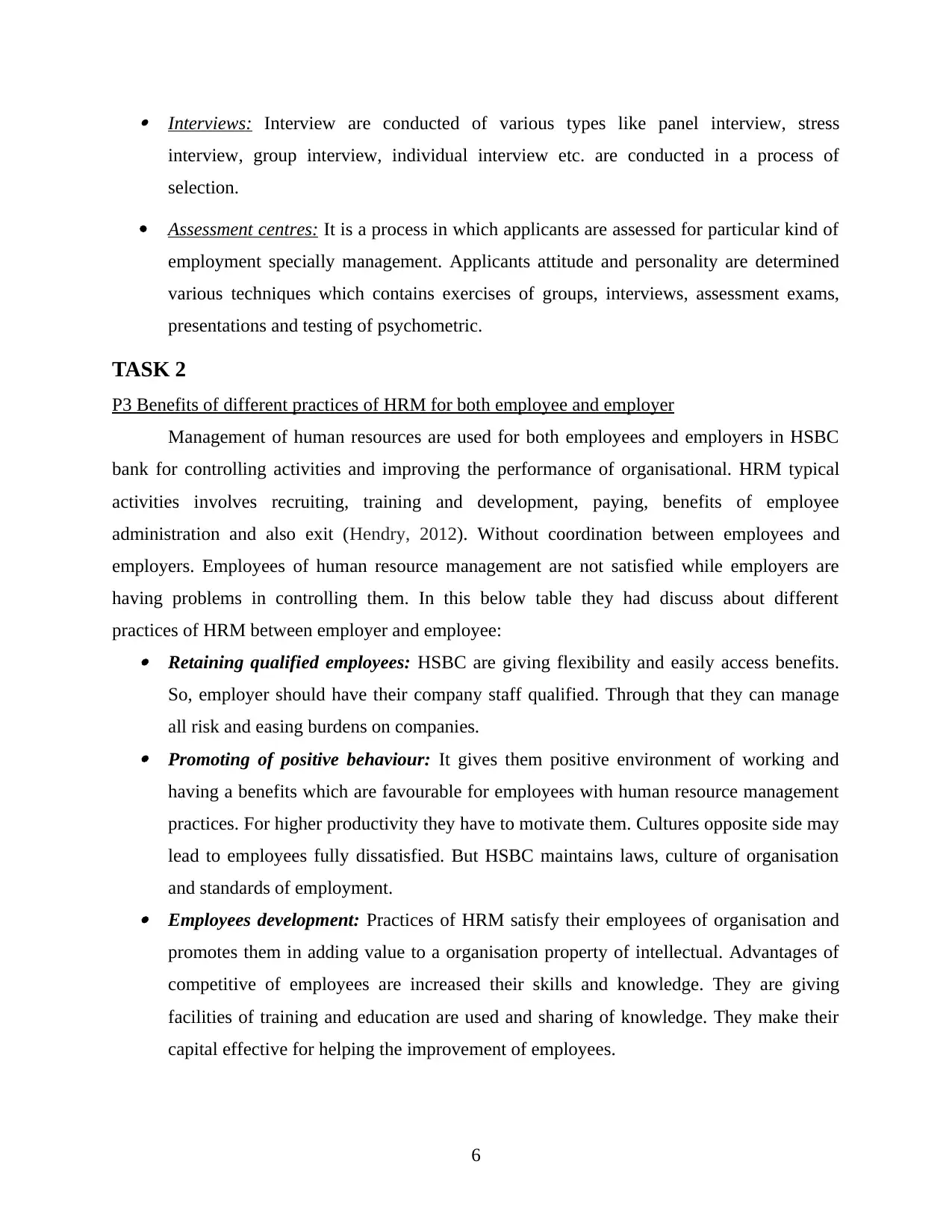
Interviews: Interview are conducted of various types like panel interview, stress
interview, group interview, individual interview etc. are conducted in a process of
selection.
Assessment centres: It is a process in which applicants are assessed for particular kind of
employment specially management. Applicants attitude and personality are determined
various techniques which contains exercises of groups, interviews, assessment exams,
presentations and testing of psychometric.
TASK 2
P3 Benefits of different practices of HRM for both employee and employer
Management of human resources are used for both employees and employers in HSBC
bank for controlling activities and improving the performance of organisational. HRM typical
activities involves recruiting, training and development, paying, benefits of employee
administration and also exit (Hendry, 2012). Without coordination between employees and
employers. Employees of human resource management are not satisfied while employers are
having problems in controlling them. In this below table they had discuss about different
practices of HRM between employer and employee: Retaining qualified employees: HSBC are giving flexibility and easily access benefits.
So, employer should have their company staff qualified. Through that they can manage
all risk and easing burdens on companies. Promoting of positive behaviour: It gives them positive environment of working and
having a benefits which are favourable for employees with human resource management
practices. For higher productivity they have to motivate them. Cultures opposite side may
lead to employees fully dissatisfied. But HSBC maintains laws, culture of organisation
and standards of employment. Employees development: Practices of HRM satisfy their employees of organisation and
promotes them in adding value to a organisation property of intellectual. Advantages of
competitive of employees are increased their skills and knowledge. They are giving
facilities of training and education are used and sharing of knowledge. They make their
capital effective for helping the improvement of employees.
6
interview, group interview, individual interview etc. are conducted in a process of
selection.
Assessment centres: It is a process in which applicants are assessed for particular kind of
employment specially management. Applicants attitude and personality are determined
various techniques which contains exercises of groups, interviews, assessment exams,
presentations and testing of psychometric.
TASK 2
P3 Benefits of different practices of HRM for both employee and employer
Management of human resources are used for both employees and employers in HSBC
bank for controlling activities and improving the performance of organisational. HRM typical
activities involves recruiting, training and development, paying, benefits of employee
administration and also exit (Hendry, 2012). Without coordination between employees and
employers. Employees of human resource management are not satisfied while employers are
having problems in controlling them. In this below table they had discuss about different
practices of HRM between employer and employee: Retaining qualified employees: HSBC are giving flexibility and easily access benefits.
So, employer should have their company staff qualified. Through that they can manage
all risk and easing burdens on companies. Promoting of positive behaviour: It gives them positive environment of working and
having a benefits which are favourable for employees with human resource management
practices. For higher productivity they have to motivate them. Cultures opposite side may
lead to employees fully dissatisfied. But HSBC maintains laws, culture of organisation
and standards of employment. Employees development: Practices of HRM satisfy their employees of organisation and
promotes them in adding value to a organisation property of intellectual. Advantages of
competitive of employees are increased their skills and knowledge. They are giving
facilities of training and education are used and sharing of knowledge. They make their
capital effective for helping the improvement of employees.
6
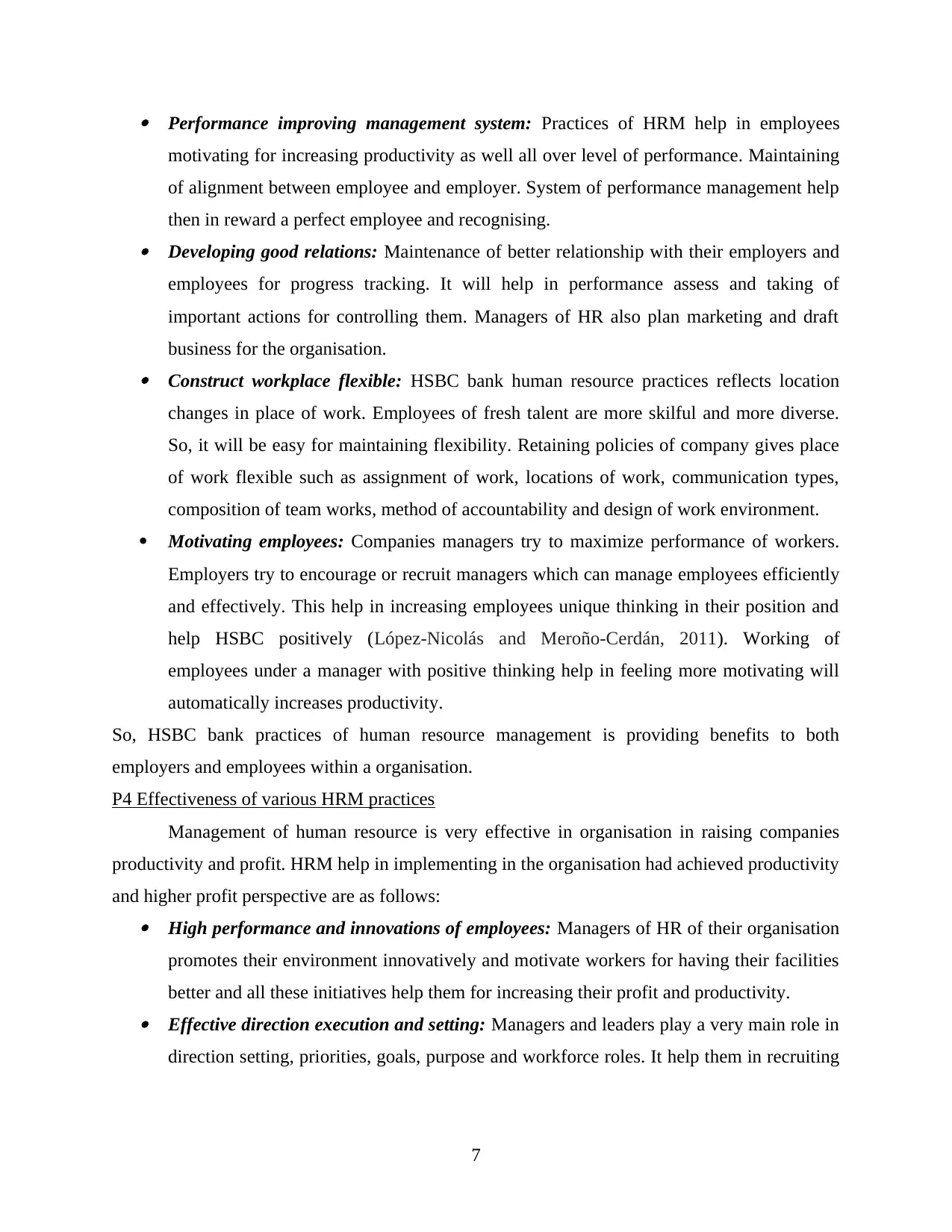
Performance improving management system: Practices of HRM help in employees
motivating for increasing productivity as well all over level of performance. Maintaining
of alignment between employee and employer. System of performance management help
then in reward a perfect employee and recognising. Developing good relations: Maintenance of better relationship with their employers and
employees for progress tracking. It will help in performance assess and taking of
important actions for controlling them. Managers of HR also plan marketing and draft
business for the organisation. Construct workplace flexible: HSBC bank human resource practices reflects location
changes in place of work. Employees of fresh talent are more skilful and more diverse.
So, it will be easy for maintaining flexibility. Retaining policies of company gives place
of work flexible such as assignment of work, locations of work, communication types,
composition of team works, method of accountability and design of work environment.
Motivating employees: Companies managers try to maximize performance of workers.
Employers try to encourage or recruit managers which can manage employees efficiently
and effectively. This help in increasing employees unique thinking in their position and
help HSBC positively (López-Nicolás and Meroño-Cerdán, 2011). Working of
employees under a manager with positive thinking help in feeling more motivating will
automatically increases productivity.
So, HSBC bank practices of human resource management is providing benefits to both
employers and employees within a organisation.
P4 Effectiveness of various HRM practices
Management of human resource is very effective in organisation in raising companies
productivity and profit. HRM help in implementing in the organisation had achieved productivity
and higher profit perspective are as follows: High performance and innovations of employees: Managers of HR of their organisation
promotes their environment innovatively and motivate workers for having their facilities
better and all these initiatives help them for increasing their profit and productivity. Effective direction execution and setting: Managers and leaders play a very main role in
direction setting, priorities, goals, purpose and workforce roles. It help them in recruiting
7
motivating for increasing productivity as well all over level of performance. Maintaining
of alignment between employee and employer. System of performance management help
then in reward a perfect employee and recognising. Developing good relations: Maintenance of better relationship with their employers and
employees for progress tracking. It will help in performance assess and taking of
important actions for controlling them. Managers of HR also plan marketing and draft
business for the organisation. Construct workplace flexible: HSBC bank human resource practices reflects location
changes in place of work. Employees of fresh talent are more skilful and more diverse.
So, it will be easy for maintaining flexibility. Retaining policies of company gives place
of work flexible such as assignment of work, locations of work, communication types,
composition of team works, method of accountability and design of work environment.
Motivating employees: Companies managers try to maximize performance of workers.
Employers try to encourage or recruit managers which can manage employees efficiently
and effectively. This help in increasing employees unique thinking in their position and
help HSBC positively (López-Nicolás and Meroño-Cerdán, 2011). Working of
employees under a manager with positive thinking help in feeling more motivating will
automatically increases productivity.
So, HSBC bank practices of human resource management is providing benefits to both
employers and employees within a organisation.
P4 Effectiveness of various HRM practices
Management of human resource is very effective in organisation in raising companies
productivity and profit. HRM help in implementing in the organisation had achieved productivity
and higher profit perspective are as follows: High performance and innovations of employees: Managers of HR of their organisation
promotes their environment innovatively and motivate workers for having their facilities
better and all these initiatives help them for increasing their profit and productivity. Effective direction execution and setting: Managers and leaders play a very main role in
direction setting, priorities, goals, purpose and workforce roles. It help them in recruiting
7
⊘ This is a preview!⊘
Do you want full access?
Subscribe today to unlock all pages.

Trusted by 1+ million students worldwide
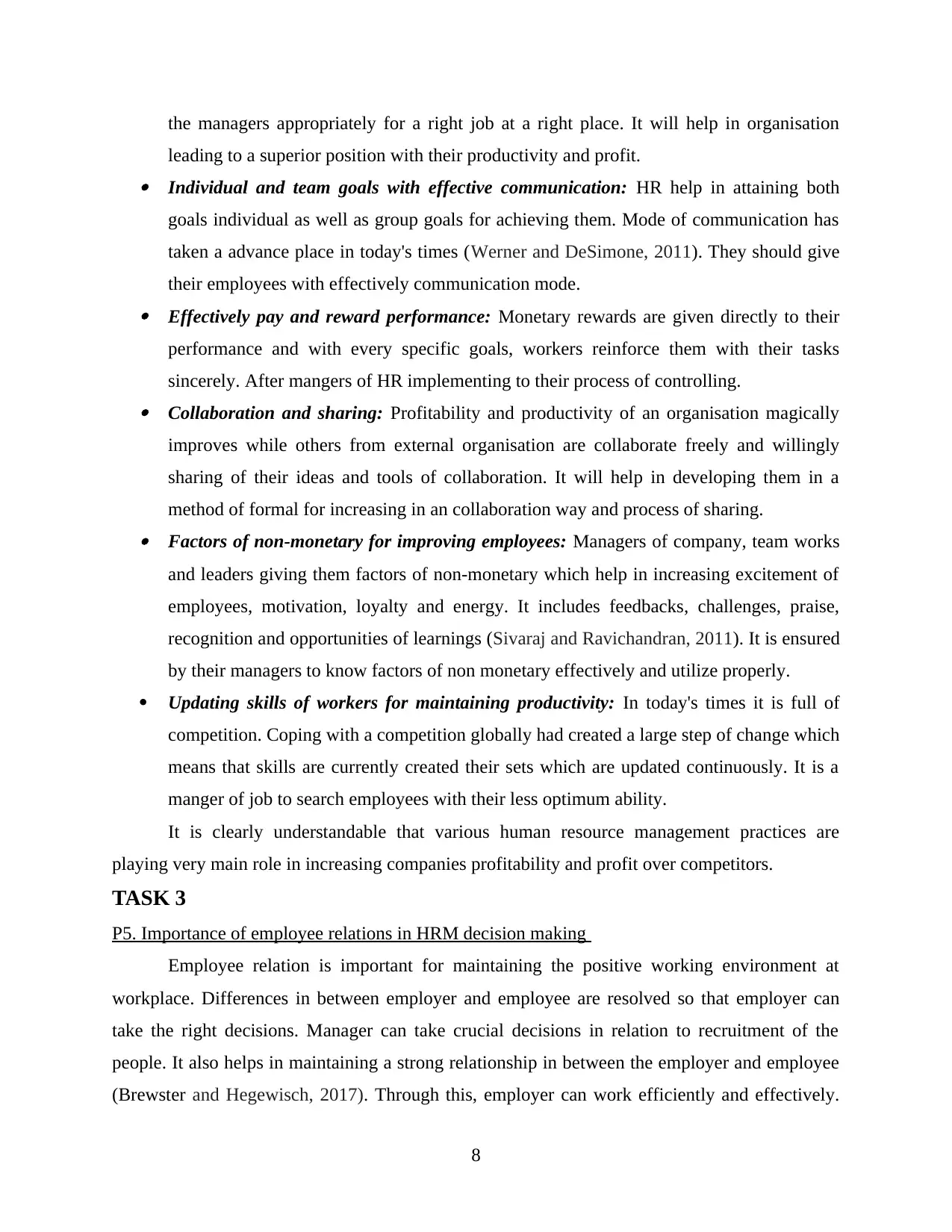
the managers appropriately for a right job at a right place. It will help in organisation
leading to a superior position with their productivity and profit. Individual and team goals with effective communication: HR help in attaining both
goals individual as well as group goals for achieving them. Mode of communication has
taken a advance place in today's times (Werner and DeSimone, 2011). They should give
their employees with effectively communication mode. Effectively pay and reward performance: Monetary rewards are given directly to their
performance and with every specific goals, workers reinforce them with their tasks
sincerely. After mangers of HR implementing to their process of controlling. Collaboration and sharing: Profitability and productivity of an organisation magically
improves while others from external organisation are collaborate freely and willingly
sharing of their ideas and tools of collaboration. It will help in developing them in a
method of formal for increasing in an collaboration way and process of sharing. Factors of non-monetary for improving employees: Managers of company, team works
and leaders giving them factors of non-monetary which help in increasing excitement of
employees, motivation, loyalty and energy. It includes feedbacks, challenges, praise,
recognition and opportunities of learnings (Sivaraj and Ravichandran, 2011). It is ensured
by their managers to know factors of non monetary effectively and utilize properly.
Updating skills of workers for maintaining productivity: In today's times it is full of
competition. Coping with a competition globally had created a large step of change which
means that skills are currently created their sets which are updated continuously. It is a
manger of job to search employees with their less optimum ability.
It is clearly understandable that various human resource management practices are
playing very main role in increasing companies profitability and profit over competitors.
TASK 3
P5. Importance of employee relations in HRM decision making
Employee relation is important for maintaining the positive working environment at
workplace. Differences in between employer and employee are resolved so that employer can
take the right decisions. Manager can take crucial decisions in relation to recruitment of the
people. It also helps in maintaining a strong relationship in between the employer and employee
(Brewster and Hegewisch, 2017). Through this, employer can work efficiently and effectively.
8
leading to a superior position with their productivity and profit. Individual and team goals with effective communication: HR help in attaining both
goals individual as well as group goals for achieving them. Mode of communication has
taken a advance place in today's times (Werner and DeSimone, 2011). They should give
their employees with effectively communication mode. Effectively pay and reward performance: Monetary rewards are given directly to their
performance and with every specific goals, workers reinforce them with their tasks
sincerely. After mangers of HR implementing to their process of controlling. Collaboration and sharing: Profitability and productivity of an organisation magically
improves while others from external organisation are collaborate freely and willingly
sharing of their ideas and tools of collaboration. It will help in developing them in a
method of formal for increasing in an collaboration way and process of sharing. Factors of non-monetary for improving employees: Managers of company, team works
and leaders giving them factors of non-monetary which help in increasing excitement of
employees, motivation, loyalty and energy. It includes feedbacks, challenges, praise,
recognition and opportunities of learnings (Sivaraj and Ravichandran, 2011). It is ensured
by their managers to know factors of non monetary effectively and utilize properly.
Updating skills of workers for maintaining productivity: In today's times it is full of
competition. Coping with a competition globally had created a large step of change which
means that skills are currently created their sets which are updated continuously. It is a
manger of job to search employees with their less optimum ability.
It is clearly understandable that various human resource management practices are
playing very main role in increasing companies profitability and profit over competitors.
TASK 3
P5. Importance of employee relations in HRM decision making
Employee relation is important for maintaining the positive working environment at
workplace. Differences in between employer and employee are resolved so that employer can
take the right decisions. Manager can take crucial decisions in relation to recruitment of the
people. It also helps in maintaining a strong relationship in between the employer and employee
(Brewster and Hegewisch, 2017). Through this, employer can work efficiently and effectively.
8
Paraphrase This Document
Need a fresh take? Get an instant paraphrase of this document with our AI Paraphraser
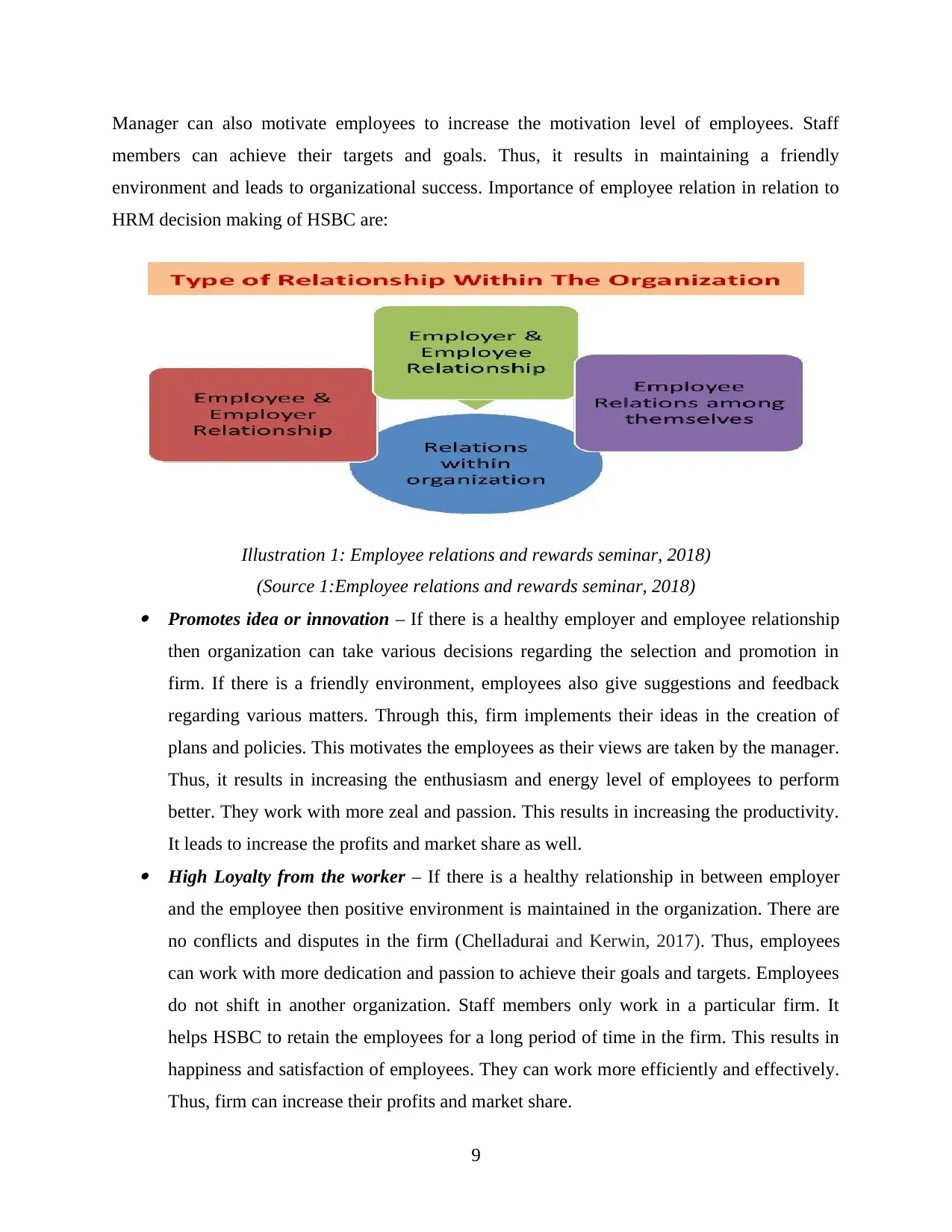
Manager can also motivate employees to increase the motivation level of employees. Staff
members can achieve their targets and goals. Thus, it results in maintaining a friendly
environment and leads to organizational success. Importance of employee relation in relation to
HRM decision making of HSBC are:
(Source 1:Employee relations and rewards seminar, 2018) Promotes idea or innovation – If there is a healthy employer and employee relationship
then organization can take various decisions regarding the selection and promotion in
firm. If there is a friendly environment, employees also give suggestions and feedback
regarding various matters. Through this, firm implements their ideas in the creation of
plans and policies. This motivates the employees as their views are taken by the manager.
Thus, it results in increasing the enthusiasm and energy level of employees to perform
better. They work with more zeal and passion. This results in increasing the productivity.
It leads to increase the profits and market share as well. High Loyalty from the worker – If there is a healthy relationship in between employer
and the employee then positive environment is maintained in the organization. There are
no conflicts and disputes in the firm (Chelladurai and Kerwin, 2017). Thus, employees
can work with more dedication and passion to achieve their goals and targets. Employees
do not shift in another organization. Staff members only work in a particular firm. It
helps HSBC to retain the employees for a long period of time in the firm. This results in
happiness and satisfaction of employees. They can work more efficiently and effectively.
Thus, firm can increase their profits and market share.
9
Illustration 1: Employee relations and rewards seminar, 2018)
members can achieve their targets and goals. Thus, it results in maintaining a friendly
environment and leads to organizational success. Importance of employee relation in relation to
HRM decision making of HSBC are:
(Source 1:Employee relations and rewards seminar, 2018) Promotes idea or innovation – If there is a healthy employer and employee relationship
then organization can take various decisions regarding the selection and promotion in
firm. If there is a friendly environment, employees also give suggestions and feedback
regarding various matters. Through this, firm implements their ideas in the creation of
plans and policies. This motivates the employees as their views are taken by the manager.
Thus, it results in increasing the enthusiasm and energy level of employees to perform
better. They work with more zeal and passion. This results in increasing the productivity.
It leads to increase the profits and market share as well. High Loyalty from the worker – If there is a healthy relationship in between employer
and the employee then positive environment is maintained in the organization. There are
no conflicts and disputes in the firm (Chelladurai and Kerwin, 2017). Thus, employees
can work with more dedication and passion to achieve their goals and targets. Employees
do not shift in another organization. Staff members only work in a particular firm. It
helps HSBC to retain the employees for a long period of time in the firm. This results in
happiness and satisfaction of employees. They can work more efficiently and effectively.
Thus, firm can increase their profits and market share.
9
Illustration 1: Employee relations and rewards seminar, 2018)
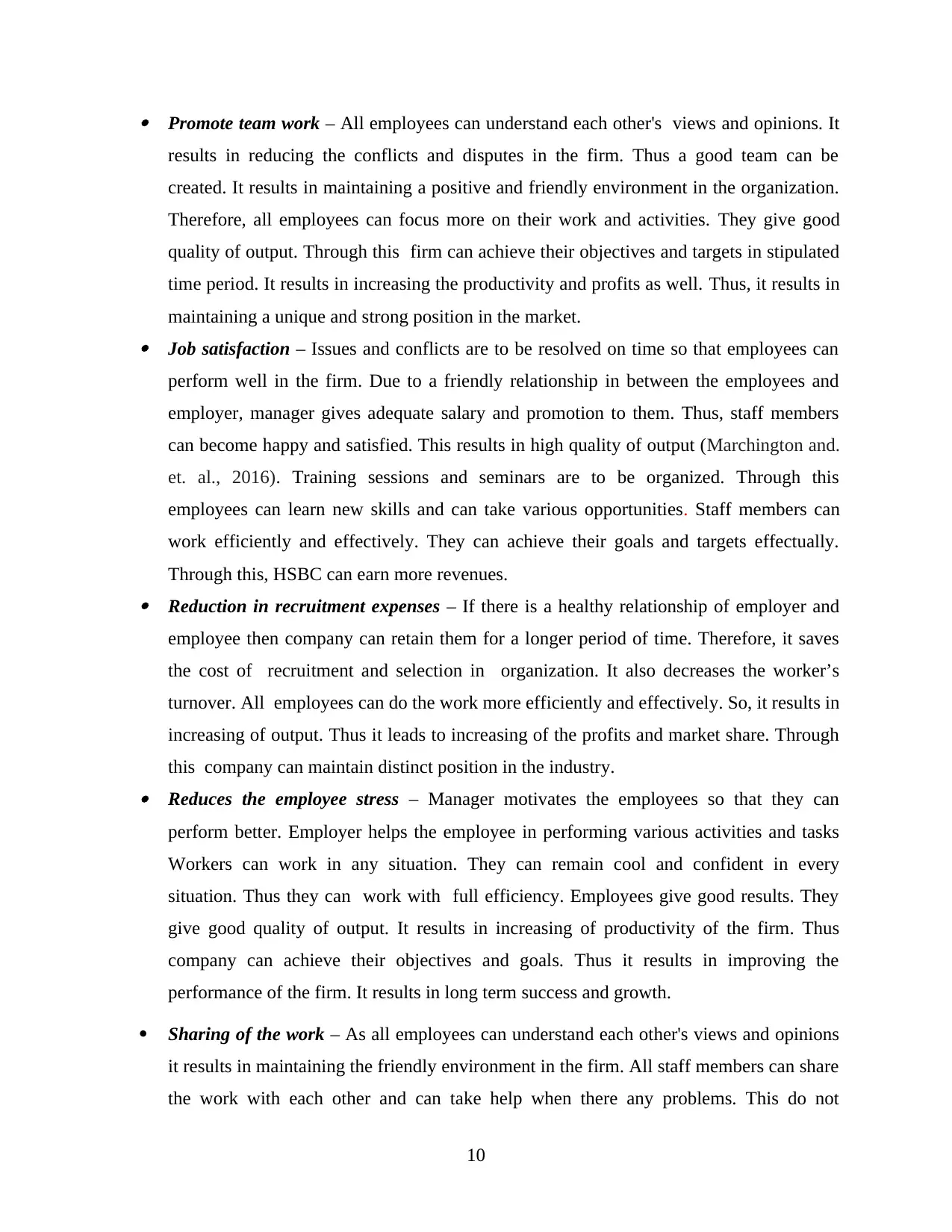
Promote team work – All employees can understand each other's views and opinions. It
results in reducing the conflicts and disputes in the firm. Thus a good team can be
created. It results in maintaining a positive and friendly environment in the organization.
Therefore, all employees can focus more on their work and activities. They give good
quality of output. Through this firm can achieve their objectives and targets in stipulated
time period. It results in increasing the productivity and profits as well. Thus, it results in
maintaining a unique and strong position in the market. Job satisfaction – Issues and conflicts are to be resolved on time so that employees can
perform well in the firm. Due to a friendly relationship in between the employees and
employer, manager gives adequate salary and promotion to them. Thus, staff members
can become happy and satisfied. This results in high quality of output (Marchington and.
et. al., 2016). Training sessions and seminars are to be organized. Through this
employees can learn new skills and can take various opportunities. Staff members can
work efficiently and effectively. They can achieve their goals and targets effectually.
Through this, HSBC can earn more revenues. Reduction in recruitment expenses – If there is a healthy relationship of employer and
employee then company can retain them for a longer period of time. Therefore, it saves
the cost of recruitment and selection in organization. It also decreases the worker’s
turnover. All employees can do the work more efficiently and effectively. So, it results in
increasing of output. Thus it leads to increasing of the profits and market share. Through
this company can maintain distinct position in the industry. Reduces the employee stress – Manager motivates the employees so that they can
perform better. Employer helps the employee in performing various activities and tasks
Workers can work in any situation. They can remain cool and confident in every
situation. Thus they can work with full efficiency. Employees give good results. They
give good quality of output. It results in increasing of productivity of the firm. Thus
company can achieve their objectives and goals. Thus it results in improving the
performance of the firm. It results in long term success and growth.
Sharing of the work – As all employees can understand each other's views and opinions
it results in maintaining the friendly environment in the firm. All staff members can share
the work with each other and can take help when there any problems. This do not
10
results in reducing the conflicts and disputes in the firm. Thus a good team can be
created. It results in maintaining a positive and friendly environment in the organization.
Therefore, all employees can focus more on their work and activities. They give good
quality of output. Through this firm can achieve their objectives and targets in stipulated
time period. It results in increasing the productivity and profits as well. Thus, it results in
maintaining a unique and strong position in the market. Job satisfaction – Issues and conflicts are to be resolved on time so that employees can
perform well in the firm. Due to a friendly relationship in between the employees and
employer, manager gives adequate salary and promotion to them. Thus, staff members
can become happy and satisfied. This results in high quality of output (Marchington and.
et. al., 2016). Training sessions and seminars are to be organized. Through this
employees can learn new skills and can take various opportunities. Staff members can
work efficiently and effectively. They can achieve their goals and targets effectually.
Through this, HSBC can earn more revenues. Reduction in recruitment expenses – If there is a healthy relationship of employer and
employee then company can retain them for a longer period of time. Therefore, it saves
the cost of recruitment and selection in organization. It also decreases the worker’s
turnover. All employees can do the work more efficiently and effectively. So, it results in
increasing of output. Thus it leads to increasing of the profits and market share. Through
this company can maintain distinct position in the industry. Reduces the employee stress – Manager motivates the employees so that they can
perform better. Employer helps the employee in performing various activities and tasks
Workers can work in any situation. They can remain cool and confident in every
situation. Thus they can work with full efficiency. Employees give good results. They
give good quality of output. It results in increasing of productivity of the firm. Thus
company can achieve their objectives and goals. Thus it results in improving the
performance of the firm. It results in long term success and growth.
Sharing of the work – As all employees can understand each other's views and opinions
it results in maintaining the friendly environment in the firm. All staff members can share
the work with each other and can take help when there any problems. This do not
10
⊘ This is a preview!⊘
Do you want full access?
Subscribe today to unlock all pages.

Trusted by 1+ million students worldwide
1 out of 19
Related Documents
Your All-in-One AI-Powered Toolkit for Academic Success.
+13062052269
info@desklib.com
Available 24*7 on WhatsApp / Email
![[object Object]](/_next/static/media/star-bottom.7253800d.svg)
Unlock your academic potential
Copyright © 2020–2025 A2Z Services. All Rights Reserved. Developed and managed by ZUCOL.




